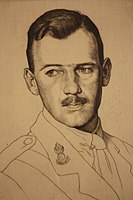William Strang
William Strang RA | |
|---|---|
Royal Academy . |
William Strang RA (13 February 1859 – 12 April 1921) was a Scottish painter and printmaker, notable for illustrating the works of Bunyan, Coleridge and Kipling.
Early life
Strang was born at
Work
He worked in many techniques: etching, drypoint, mezzotint, sand-ground mezzotint, burin engraving, lithography and woodcut. He cut a large wood engraving of a man ploughing, later published by the Art for Schools Association. A privately produced catalogue of his engraved work contained more than three hundred items. Amongst his earlier works were Tinkers, St. Jerome, A Woman Washing Her Feet, An Old Book-stall with a Man Lighting His Pipe from a Flare, and The Head of a Peasant Woman on sand-ground mezzotint. Later plates such as Hunger, The Bachelor's End and The Salvation Army were also important.
Some of his best etchings were done as series—one of the earliest, illustrating poet William Nicholson's Ballad of
Painting
Strang produced many paintings,
He also painted
-
Lady with a Red Hat (Vita Sackville-West) (1918; Kelvingrove Museum and Art Gallery, Glasgow)
-
The Temptation (1899;Tate Gallery)
Literary works
Strang also ventured into literature, creating "Death and the Ploughman's Wife", an illustrated ballad in 1888 (published 1894 by Lawrence and Bullen). He also wrote short stories, but these were not published.
Recognition
Strang was a member of the Art Workers' Guild, being elected as Master in 1907.[7][8] In 1918, he became President of the International Society of Sculptors, Painters and Gravers and in 1921 was elected an Engraver Member of the Royal Academy.[9]
Family
In 1885, William Strang married Agnes McSymon Rogerson (d. 1933), also from Dumbarton. They had four sons and one daughter. Their sons Ian Strang (1886–1952) and David Strang (1887–1967) were both artists.[10] William had at least one granddaughter, Joan Strang, born of David's short-lived marriage to the English soprano Dora Labbette.[11]
In 1955 David Strang gave impressions of the bulk of William Strang's etchings to the
Etchings
-
The Cause of the Poor, 1890
-
Henry Austin Dobson, 1895
-
Rudyard Kipling, 1901
-
His son David Strang, c. 1915
-
The cover of Death and the Ploughman's Wife
-
Death the Judge, from the twelve-image portfolio The Doings of Death (1901)
-
Old Walls And Roman Viaduct, Segovia
References
- ^ a b Jones, Sarah Urwin (10 October 2014). "William Strang's rare talent is etched in history". Glasgow Herald. Retrieved 30 October 2014.
- ^ "Manoah's Offering, from the etching by William Strang" in The Magazine of Art, Vol. 1 (1903), p. 178
- ^ "Beardsley (Aubrey Vincent)" in T. Bose, Paul Tiessen, eds., Bookman's Catalogue Vol. 1 A-L: The Norman Colbeck Collection (UBC Press, 1987), p. 41
- ^ Goodchild, Anne. "William Strang 1859–1921". Tate Etc. Retrieved 30 October 2014.
- ^ Marsh, Jan. "William Strang (1859–1921), Painter and etcher". National Portrait Gallery. Retrieved 30 October 2014.
- ^ Paths of Glory. Friends of Kensal Green Cemetery. 1997. p. 95.
- ^ Past Master List (PDF). Art Workers' Guild.
- ^ Joseph Edwards, Frederick William Pethick-Lawrence Baron Pethick-Lawrence (1908). The Reformers' Year Book. p. 208.
- ^ "William Strang". National Galleries. Retrieved 20 October 2021.
- ISBN 978-0-19-923965-8.
- ^ International, MusicWeb. "Charles A. Hooey – MusicWeb-International". musicweb-international.com.
- ^ National Gallery of Scotland: David Strang Gift, collection notes
- Attribution
This article incorporates text from a publication now in the public domain: Chisholm, Hugh, ed. (1911). "Strang, William". Encyclopædia Britannica. Vol. 25 (11th ed.). Cambridge University Press. p. 982.
External links
- 53 artworks by or after William Strang at the Art UK site
- Short biography of William Strang at 'Yellow Nineties Online'
- Sinbad the Sailor and Ali Baba and the Forty Thieves, illustrated by Strang and Joseph Benwell Clark, openly online in the University of Florida Digital Collections
- Laurence Binyon, William Strang: Catalogue of his etched work (1906) complete at wikimedia.org











